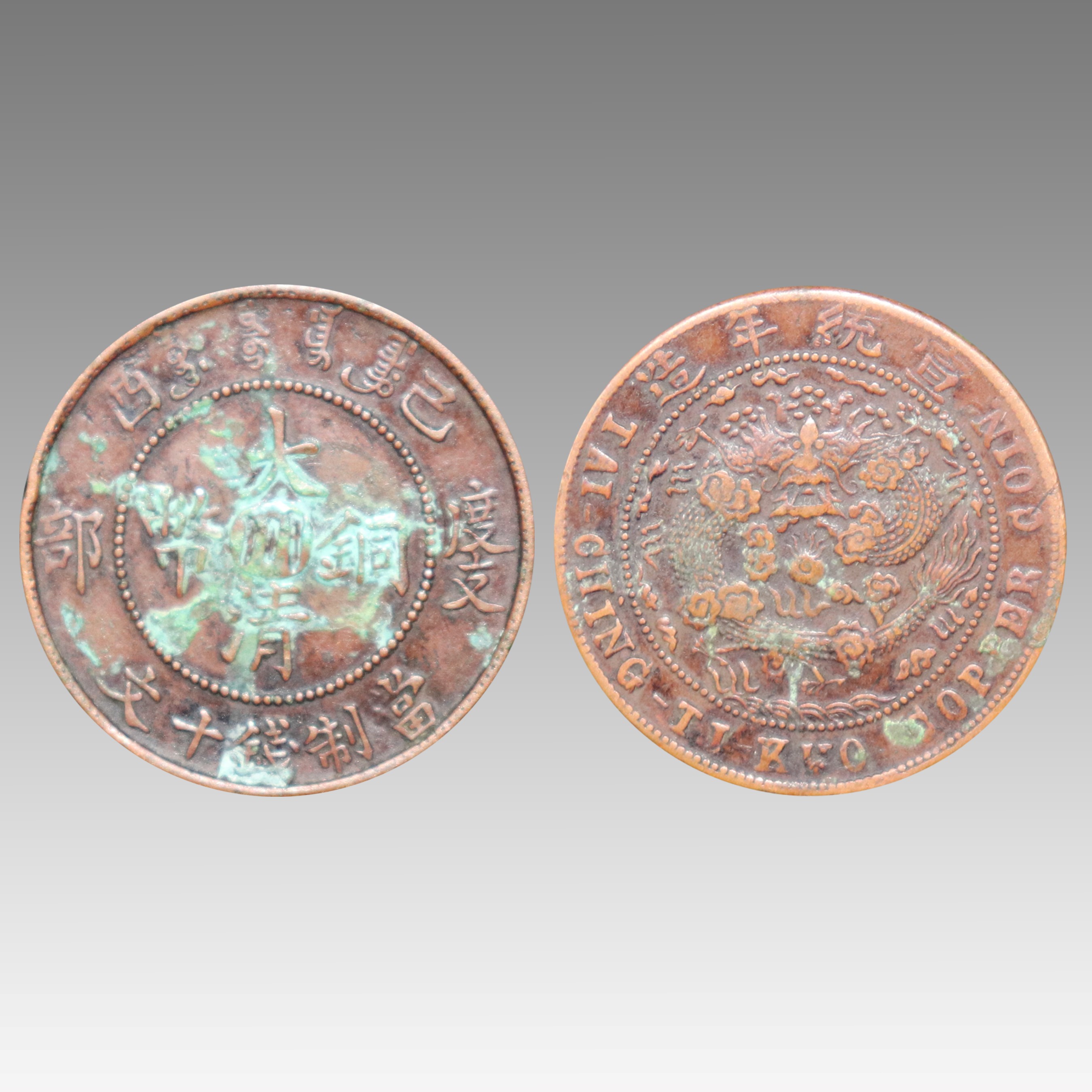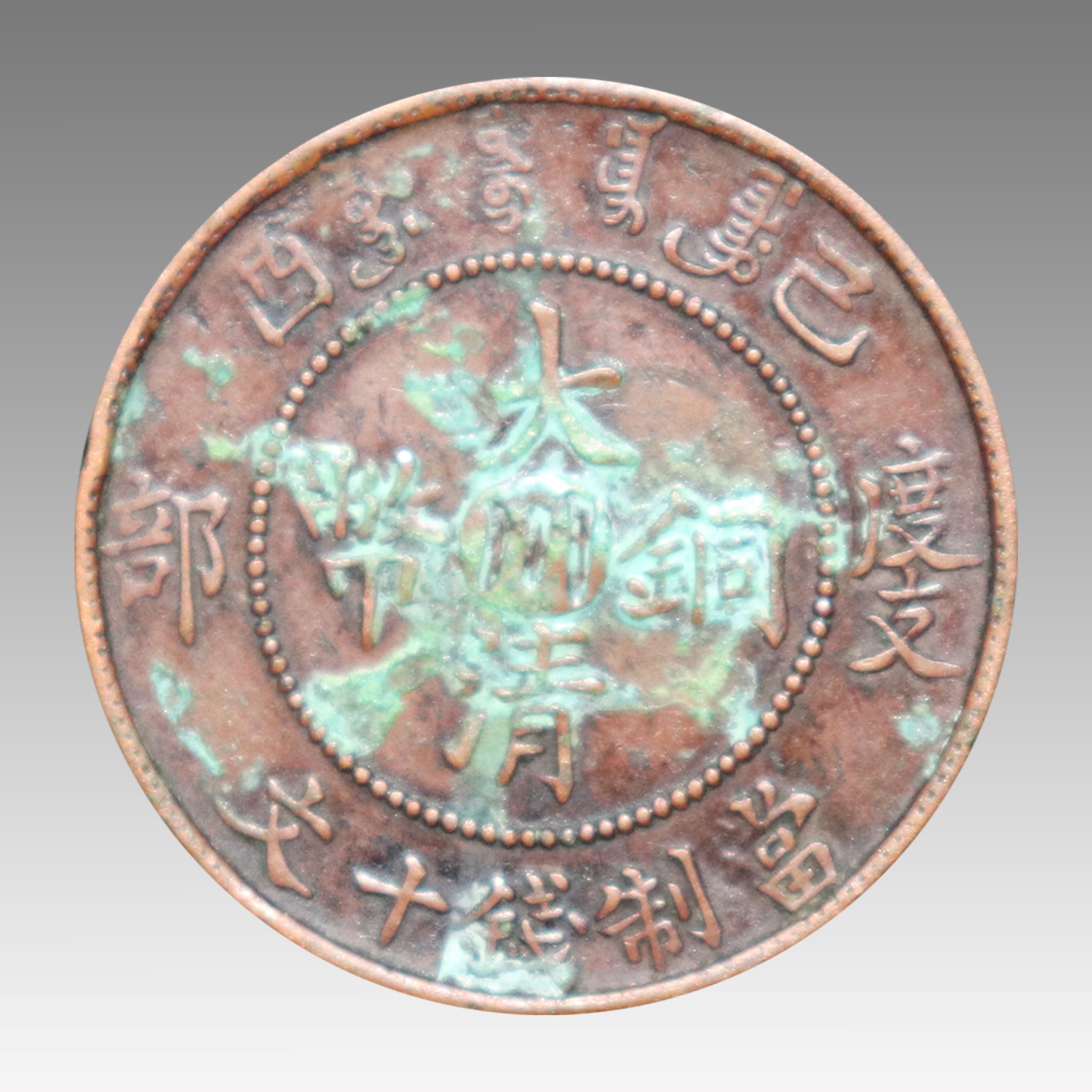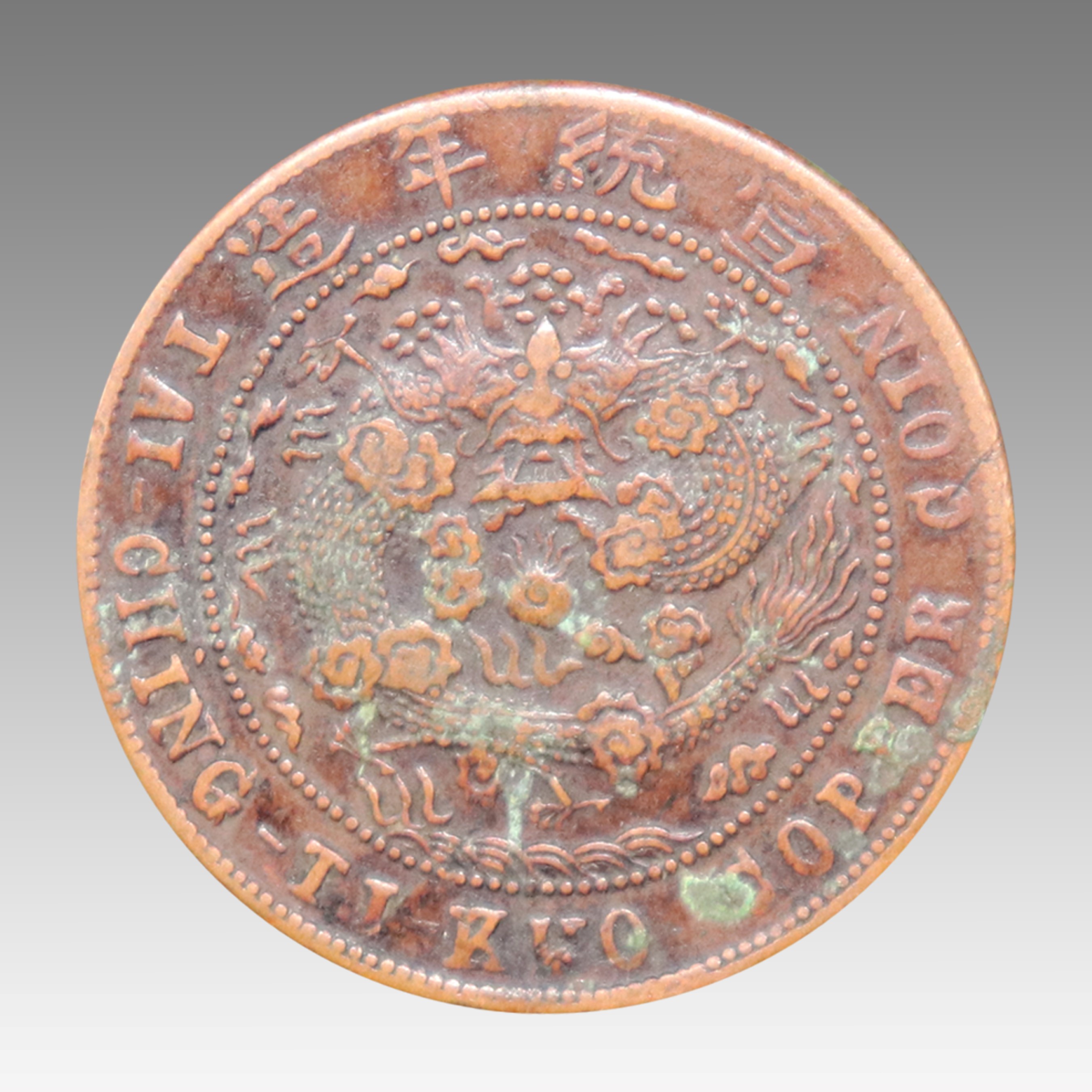大清銅幣當(dāng)十文
大清銅幣,學(xué)名清代機(jī)制銅圓,錢(qián)面中央有“大清銅幣”四個(gè)漢字,內(nèi)嵌一小字代表地名,上端是滿文“大清銅幣”字樣,兩側(cè)為年份。邊緣中間分別“度支部”三漢字,下端為“當(dāng)制錢(qián)十文”。錢(qián)背中央為蟠龍,上端是“宣統(tǒng)年造”,下端英文“Tai-Ching Ti-Kuo Copper Coin”字樣(大清帝國(guó)銅幣)。大清銅幣版式繁多,尤以當(dāng)十者為最。多位清帝在位時(shí)發(fā)行過(guò)銅幣來(lái)作為流通貨幣,銅幣的使用具有重要的現(xiàn)實(shí)意義和歷史意義,使交易逐漸便利起來(lái)。而如今,大清銅幣也具有一定的收藏價(jià)值,許多收藏家對(duì)大清銅幣愛(ài)不釋手,而收集多種多樣的銅幣已經(jīng)成為了他們的目標(biāo)。
古錢(qián)幣極具觀賞性與歷史價(jià)值,因此古錢(qián)幣如同其他古玩一樣被藏家們所青睞。中國(guó)最早的機(jī)制洋式銀元為光緒年間的“光緒元寶”,俗稱(chēng)“龍洋”,因錢(qián)幣背面 一般鑄有龍紋而得名。珍稀古錢(qián)幣是貨幣歷史的實(shí)物,由于早已不在流通領(lǐng)域,留存下來(lái)的亦少之極少,更是歷史的見(jiàn)證。

因清代以來(lái)經(jīng)歷了多場(chǎng)戰(zhàn)爭(zhēng),龍紋光緒元寶損失嚴(yán)重,至今,數(shù)量已經(jīng)極其有限。龍紋光緒元寶,這種元寶非常獨(dú)特,它所代表的不僅僅是金錢(qián),還有光緒年間的 經(jīng)濟(jì)情況。為此,眾多收藏家都紛涌而至,以期能夠找出龍紋光緒元寶,以滿足清代經(jīng)濟(jì)研究所需。
自2008年以來(lái),錢(qián)幣藏品在各大交易會(huì)上風(fēng)頭鵲起,國(guó)內(nèi)外對(duì)于清朝龍洋、龍郵的熱捧不斷升級(jí),讓眾多的投資者感受到了中國(guó)龍藏品的收藏價(jià)值和潛力。
據(jù)調(diào)查數(shù)據(jù)顯示,目前我國(guó)有超過(guò)6700人在孜孜不倦地追求龍紋光緒元寶。我國(guó)有67.3%的富豪都喜愛(ài)收藏龍紋光緒元寶,因?yàn)槠浔V的芰O高,能夠?yàn)橥顿Y者創(chuàng)作巨大的財(cái)富,而且也是身份地位和品味的象征。
此藏品出自四川成都劉先生之手,為祖?zhèn)髦铮幻缎⌒〉墓佩X(qián)幣,蘊(yùn)藏著豐富的歷史元素。如今遺傳在世的精品古錢(qián)幣雖然并不多,但是每枚精品古幣價(jià)值卻是不菲。古錢(qián)幣的價(jià)格是由存世量、藝術(shù)價(jià)值和歷史價(jià)值判斷的,而且隨著市場(chǎng)供需關(guān)系的變化而產(chǎn)生不同程度的波動(dòng)。

The Qing Dynasty copper coin, with the scientific name of Qing Dynasty copper yuan, has four Chinese characters "Qing Dynasty copper coin" in the center of the coin face, embedded with a small word to represent the place name, and the Manchu character "Qing Dynasty copper coin" on the top, with the year on both sides. There are three Chinese characters "Du branch" in the middle of the edge and "Dang Qian Shi Wen" in the bottom. The central part of Qian Bei is a pan dragon, the upper part is "made in Xuantong year", and the lower part is "Tai Ching Ti Kuo copper coin" (copper coins of the Qing Dynasty). There were many types of copper coins in the Qing Dynasty, especially the ten. A number of Qing emperors issued copper coins as circulation currency. The use of copper coins has important practical and historical significance, making the transaction more and more convenient. Today, the Qing Dynasty copper coins also have a certain collection value, many collectors can't let go of the Qing Dynasty copper coins, and collecting a variety of copper coins has become their goal.Ancient coins are of great ornamental and historical value, so they are favored by collectors like other antiques. The earliest mechanism of Chinese foreign silver dollar is "Guangxu Yuanbao" in Guangxu period, commonly known as "Longyang", which is named after the dragon pattern on the back of the coin. Rare ancient coins are the material objects of the history of money. Because they are no longer in the circulation field, there are few left, and they are the witness of history.
Since the Qing Dynasty, there have been many wars, and the loss of Guangxu Yuanbao in Longwen county is very serious. Longwen Guangxu Yuanbao, which is very unique, represents not only money, but also the economic situation of Guangxu period. For this reason, many collectors are rushing to find out the dragon pattern Guangxu Yuanbao to meet the needs of economic research in the Qing Dynasty.Since 2008, the coin collection has become popular in various trade fairs, and the popularity of Longyang and Longyou in Qing Dynasty has been continuously upgraded at home and abroad, which makes many investors feel the collection value and potential of China's Dragon collection.According to the survey data, at present, more than 6700 people in China are tirelessly pursuing Longwen Guangxu Yuanbao. In China, 67.3% of the rich like to collect Longwen Guangxu Yuanbao, because it has a very high ability of preserving value, can create huge wealth for investors, and is also a symbol of status and taste.

This collection was created by Mr. Liu in Chengdu, Sichuan Province. It's a small ancient coin with rich historical elements. Although there are not many fine ancient coins inherited in the world, the value of each fine ancient coin is not poor. The price of ancient coins is determined by the amount of money, artistic value and historical value, and fluctuates with the change of market supply and demand.






